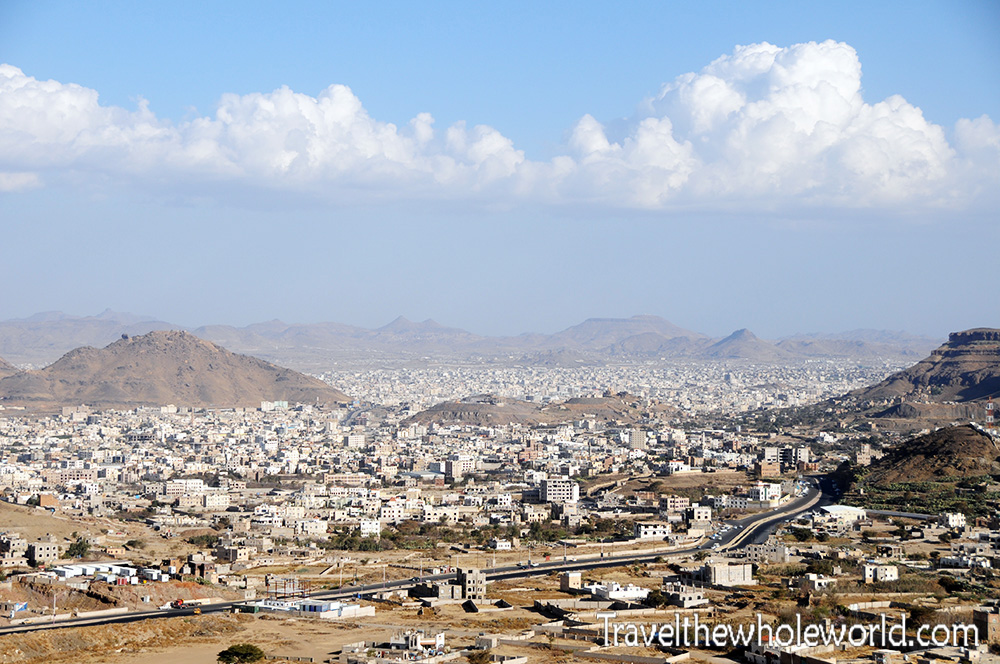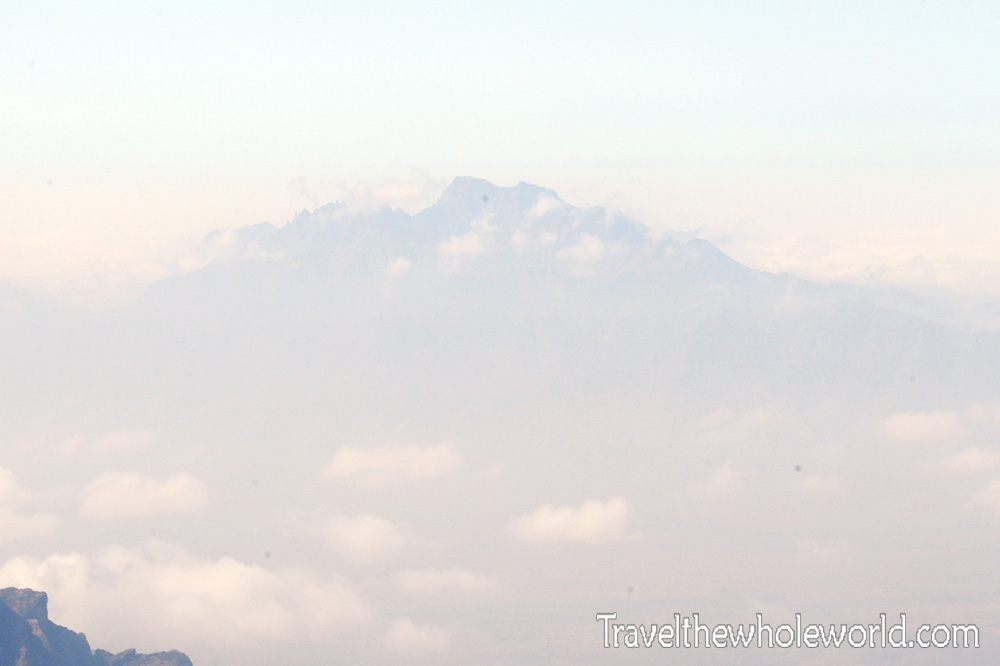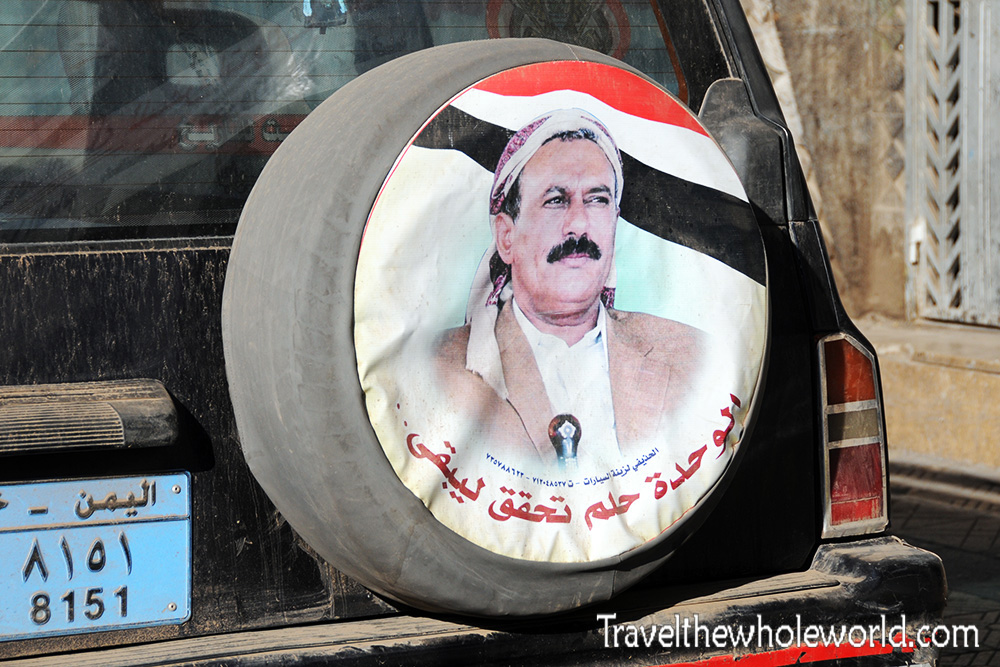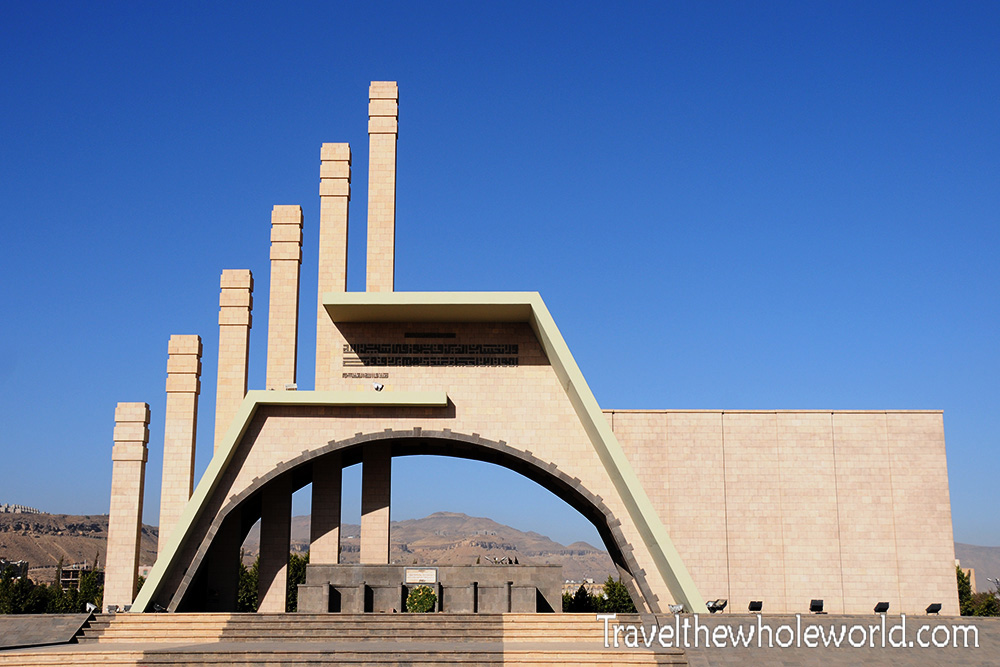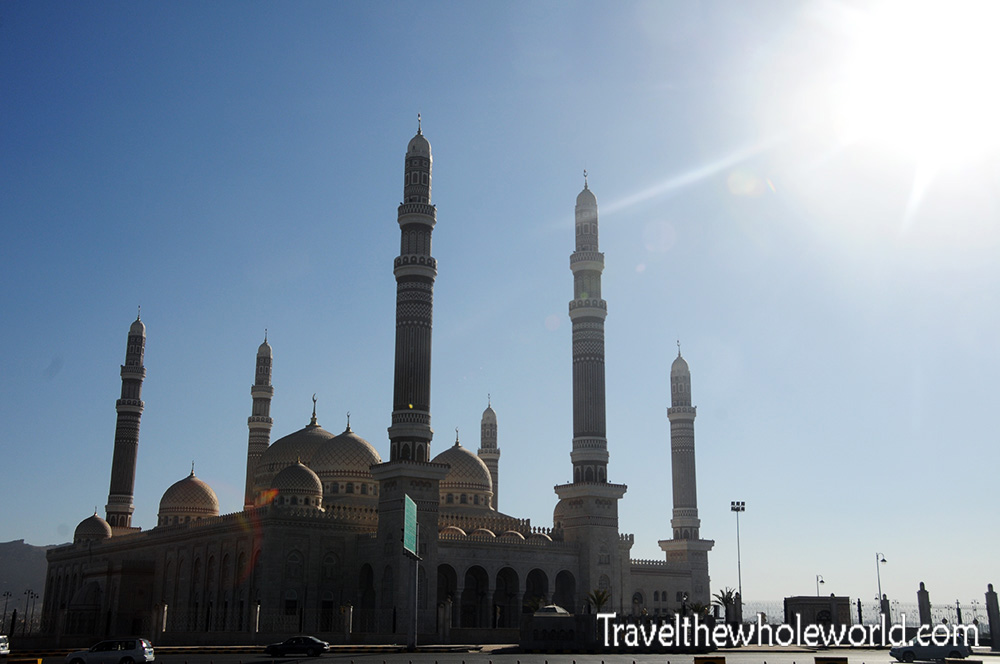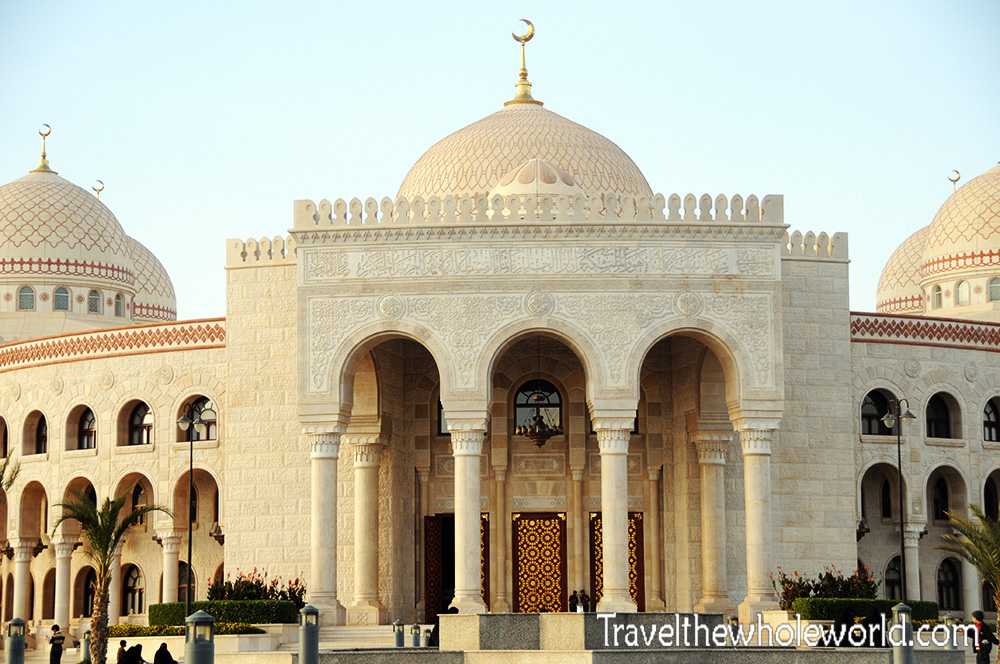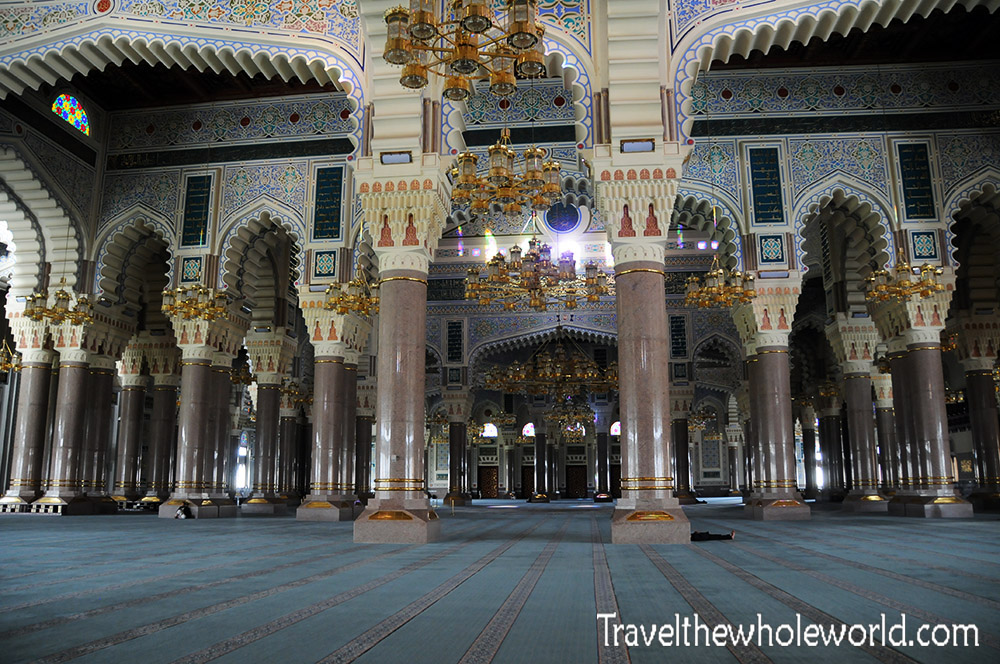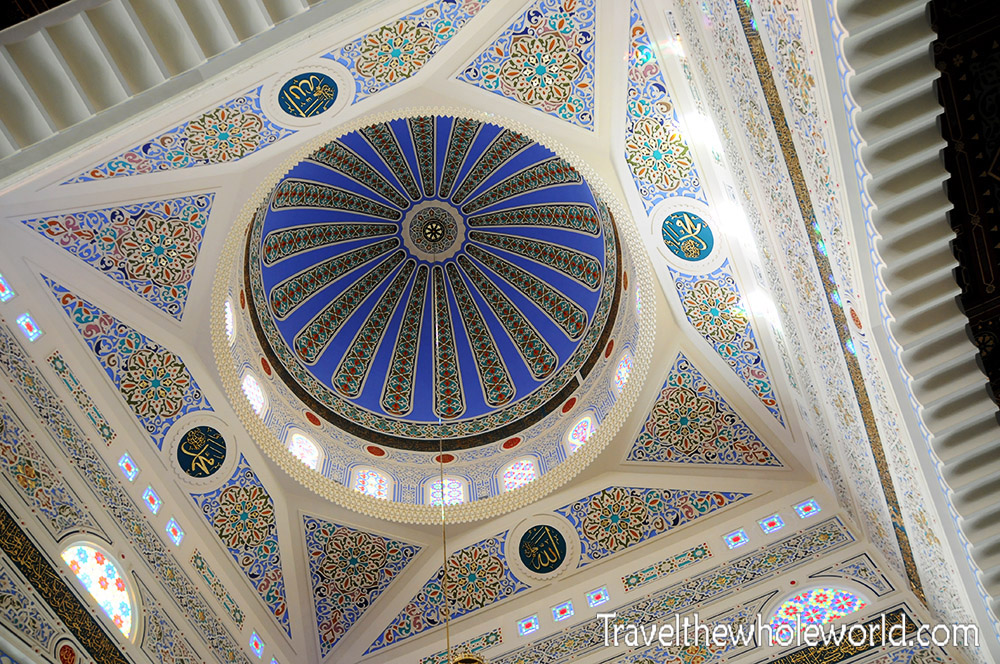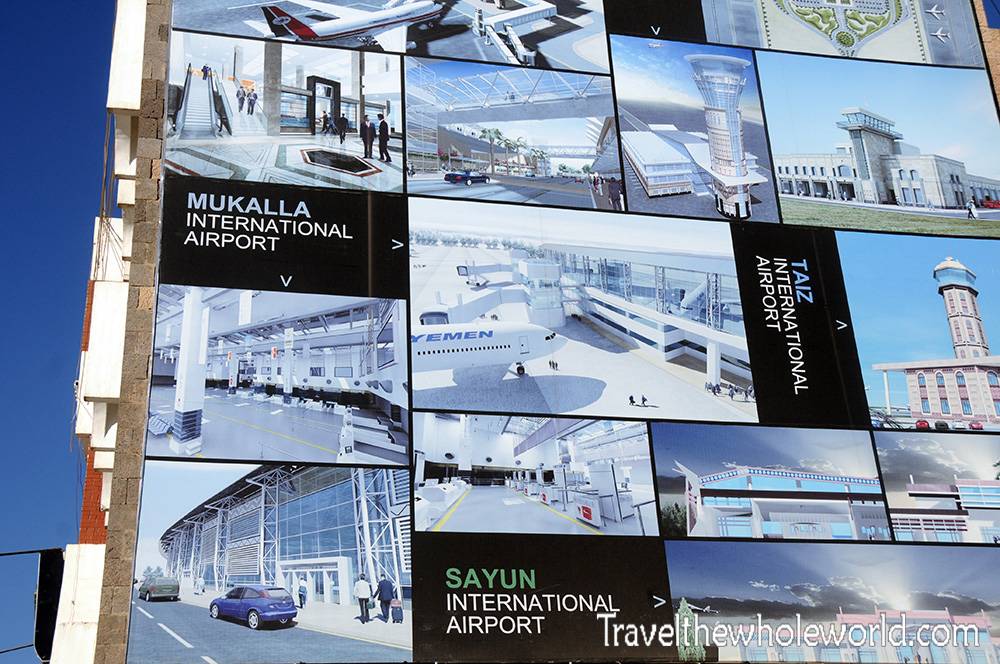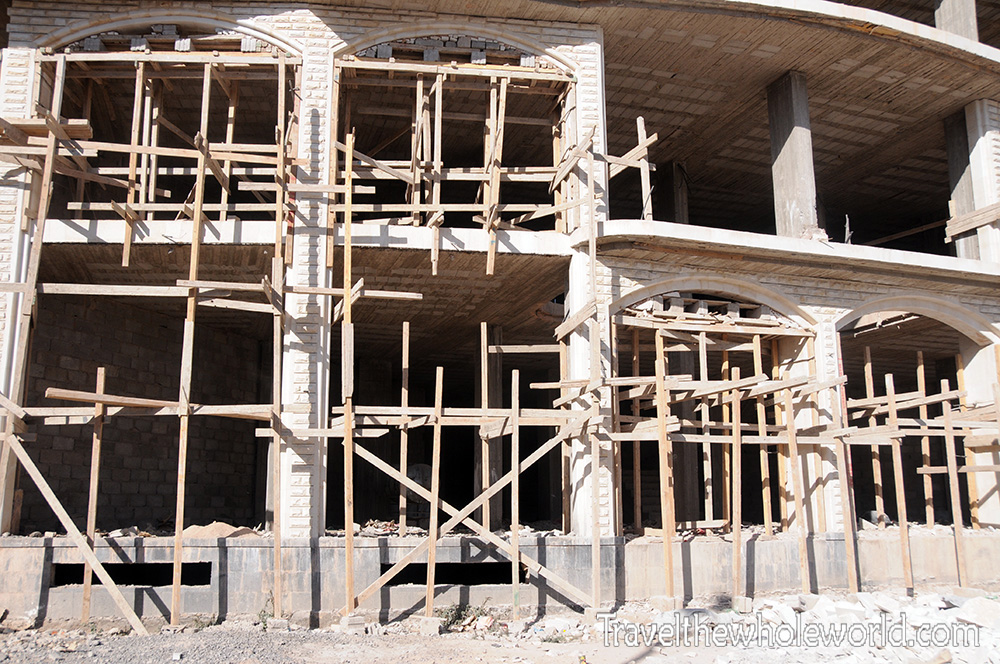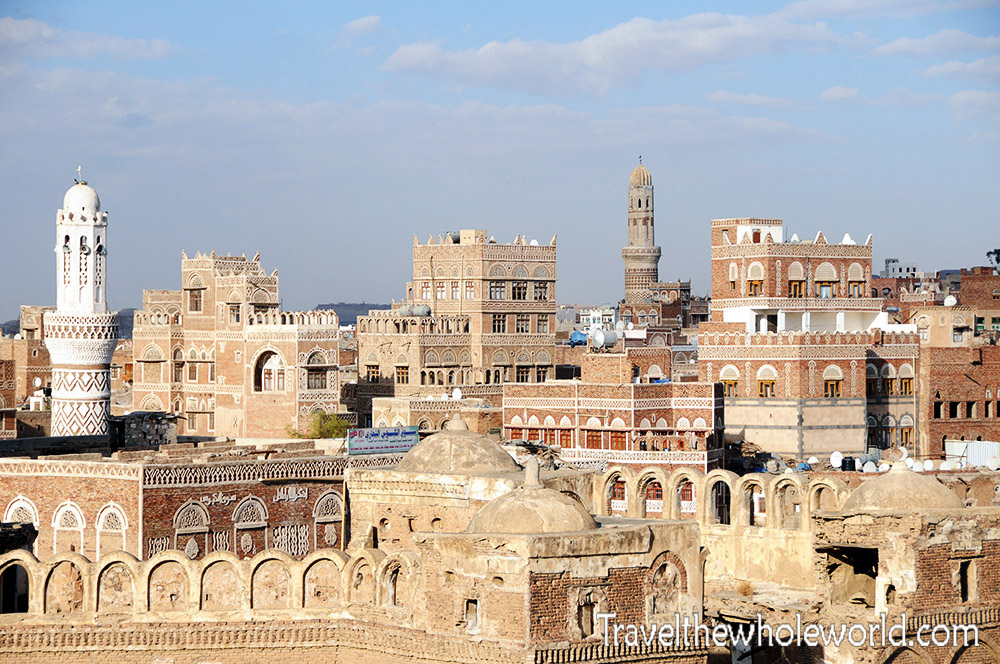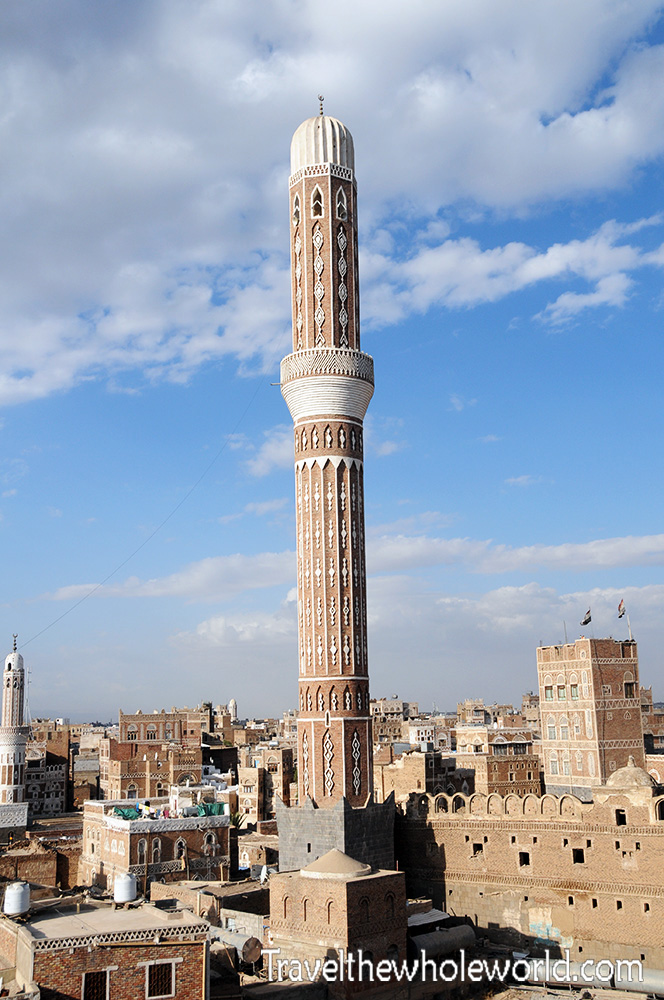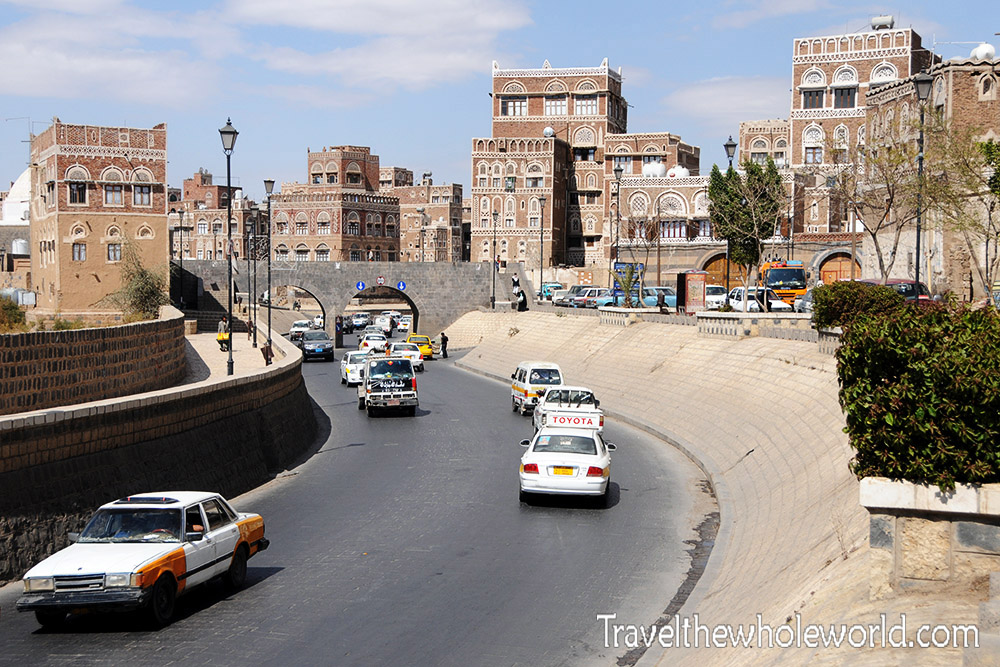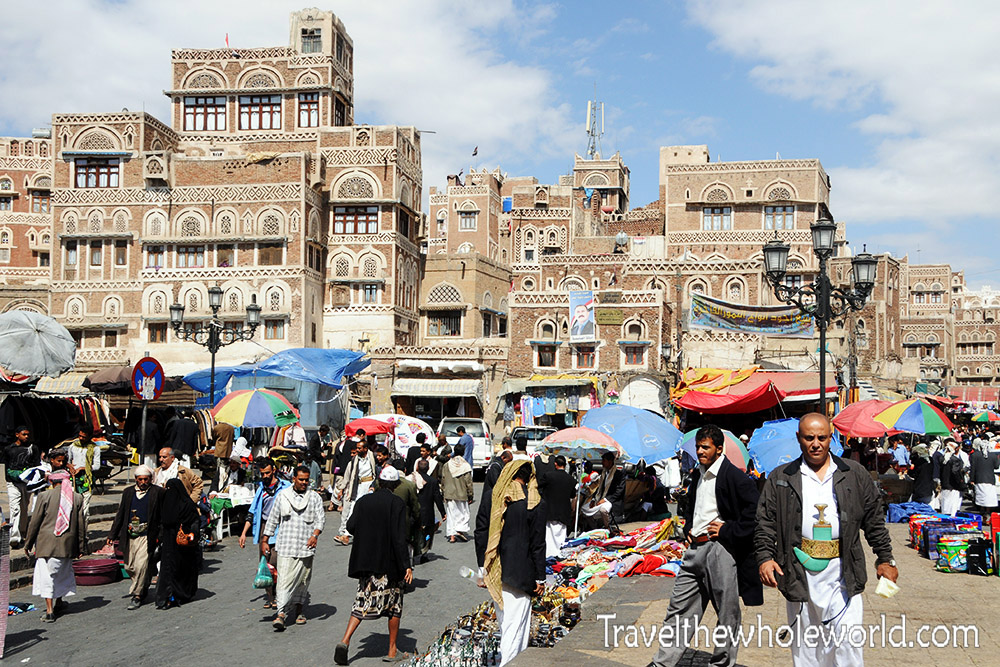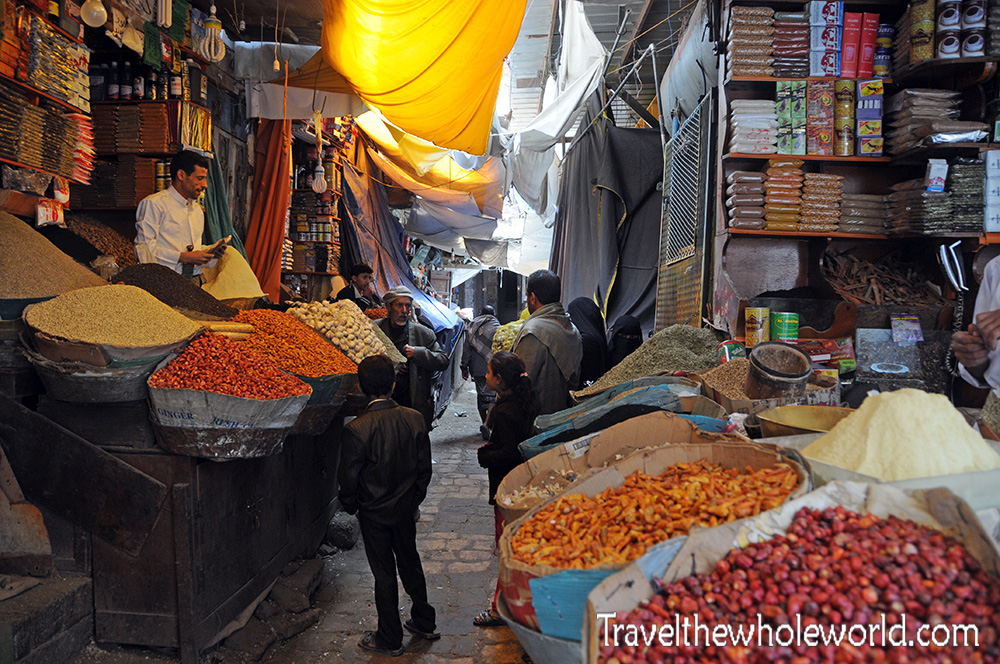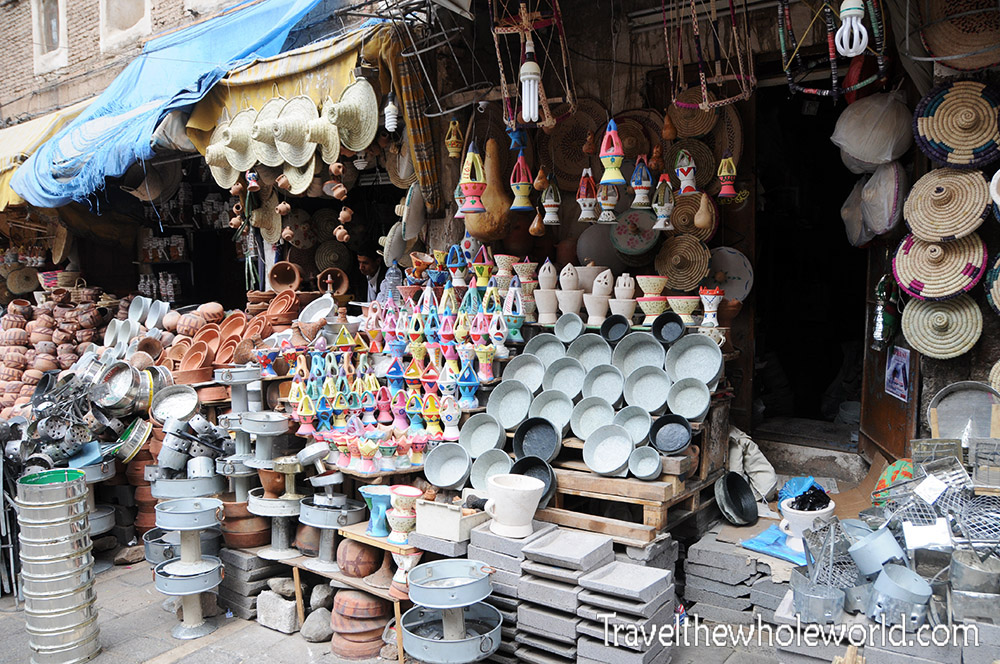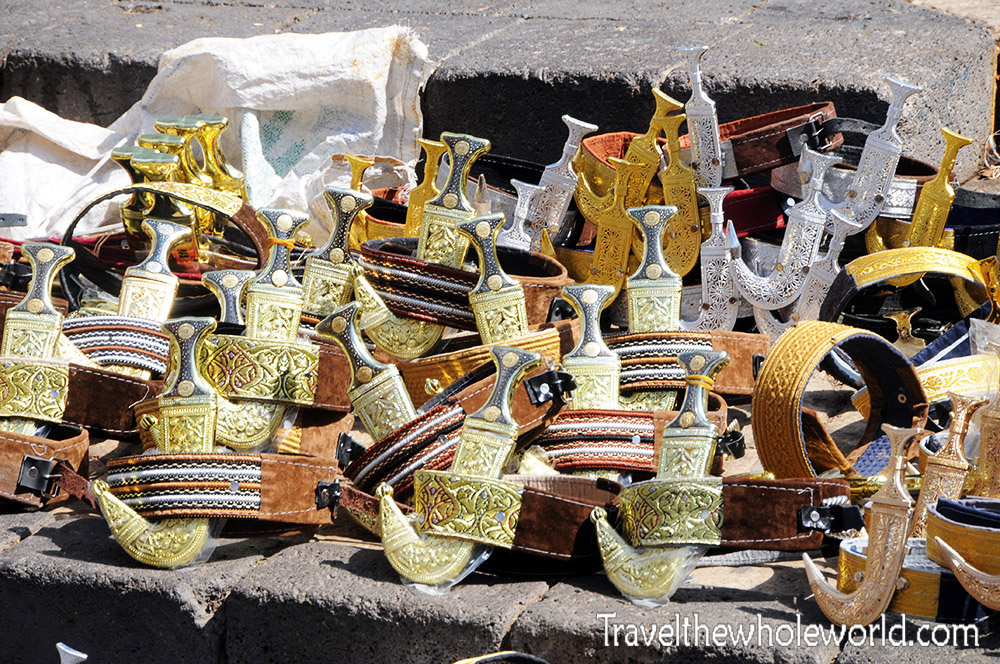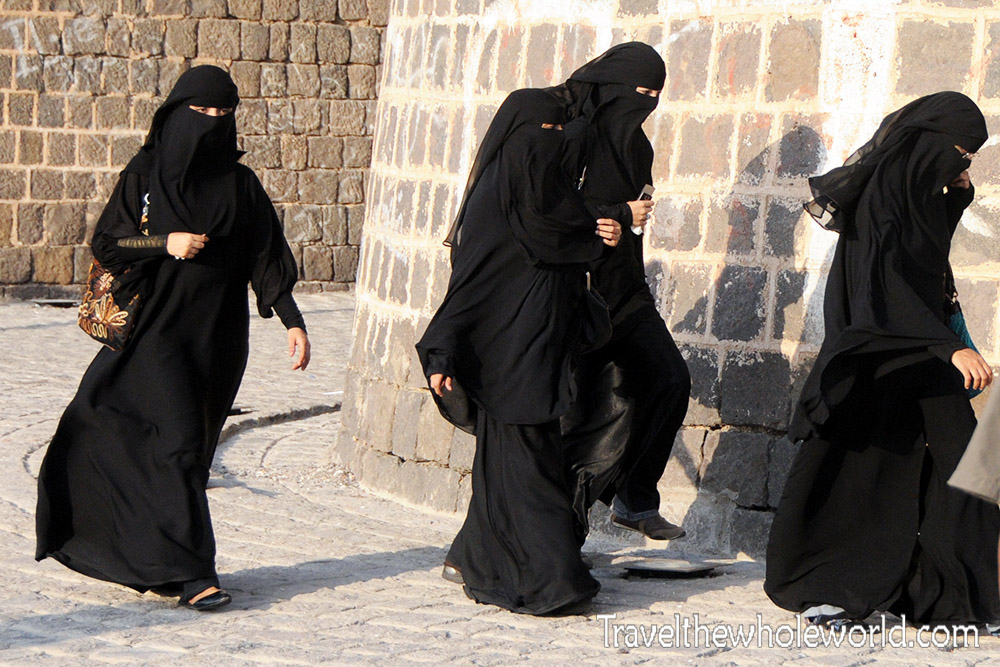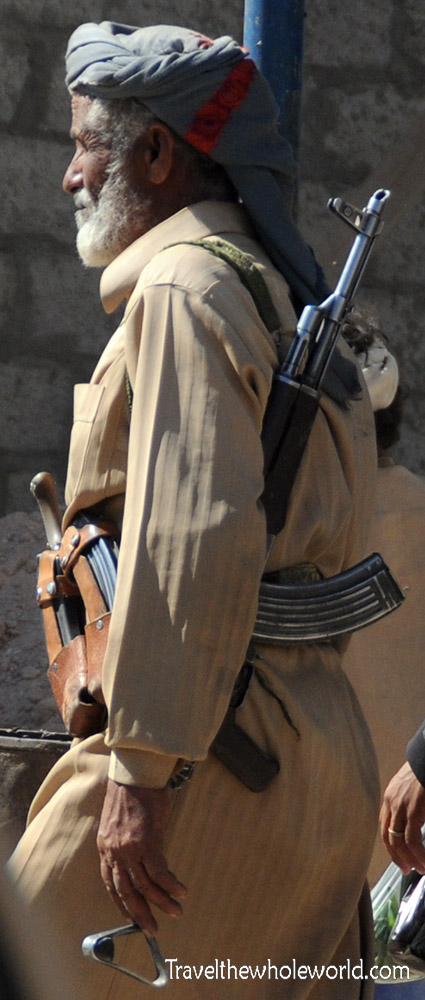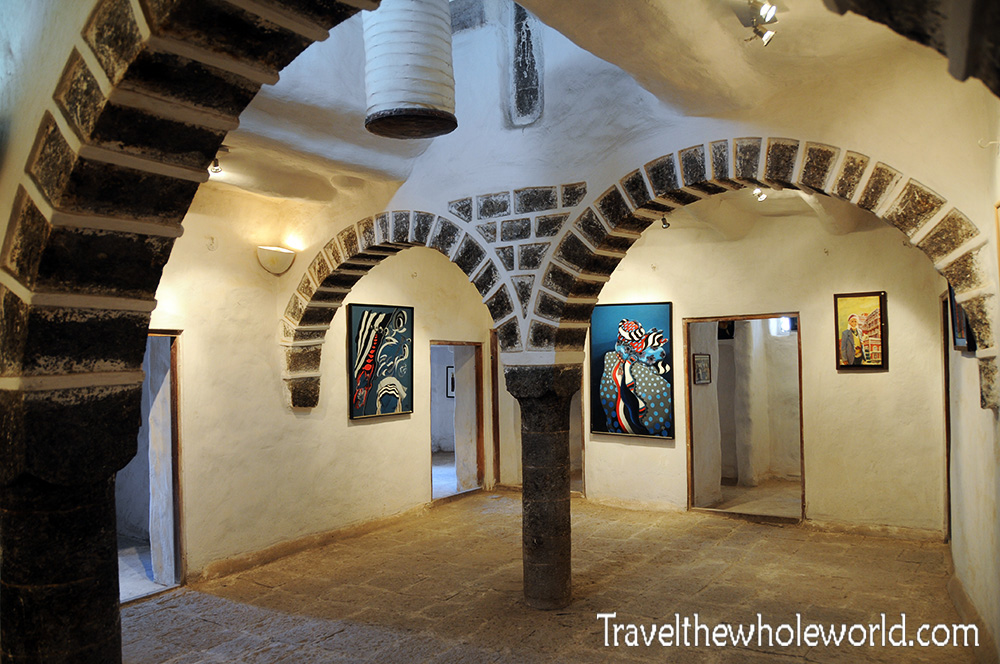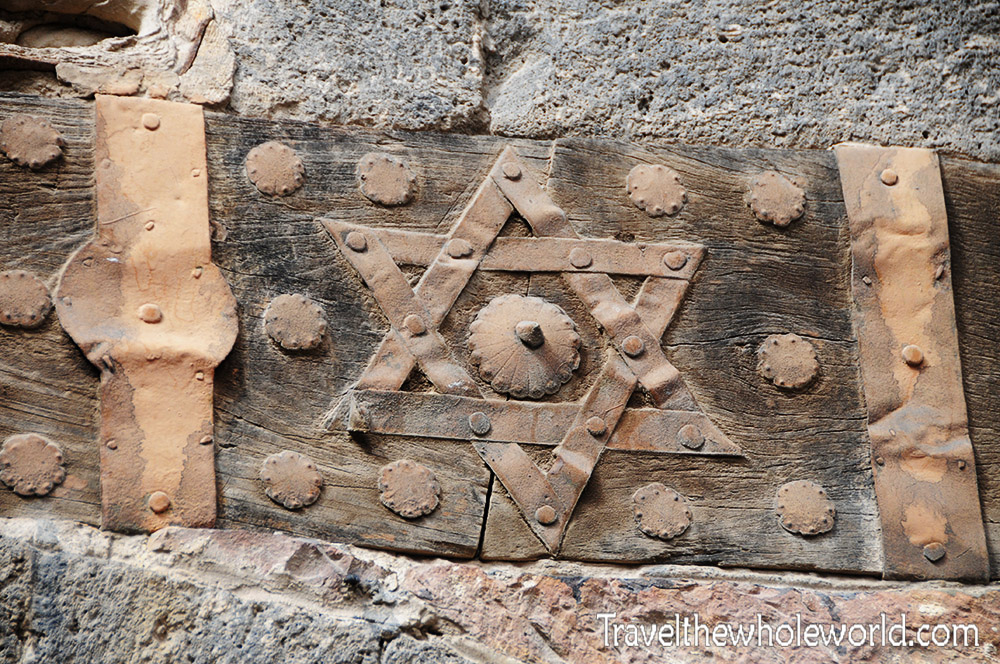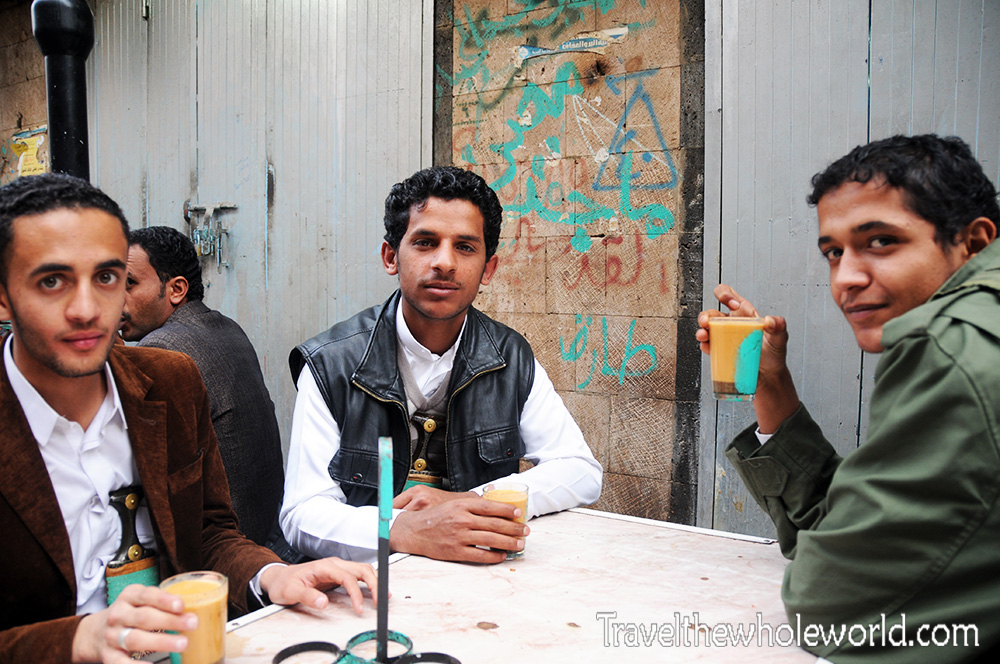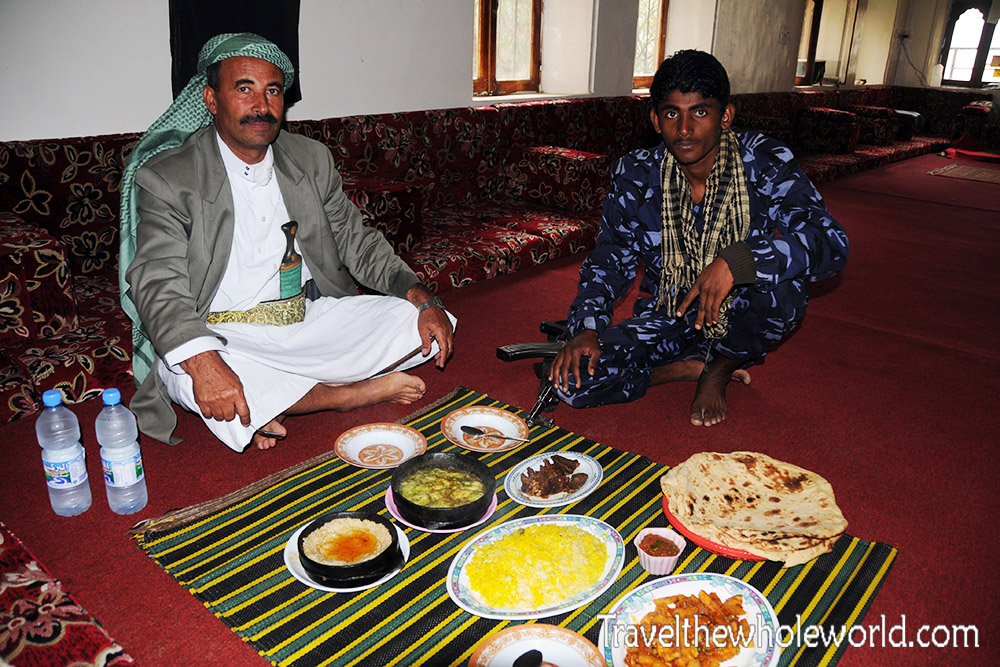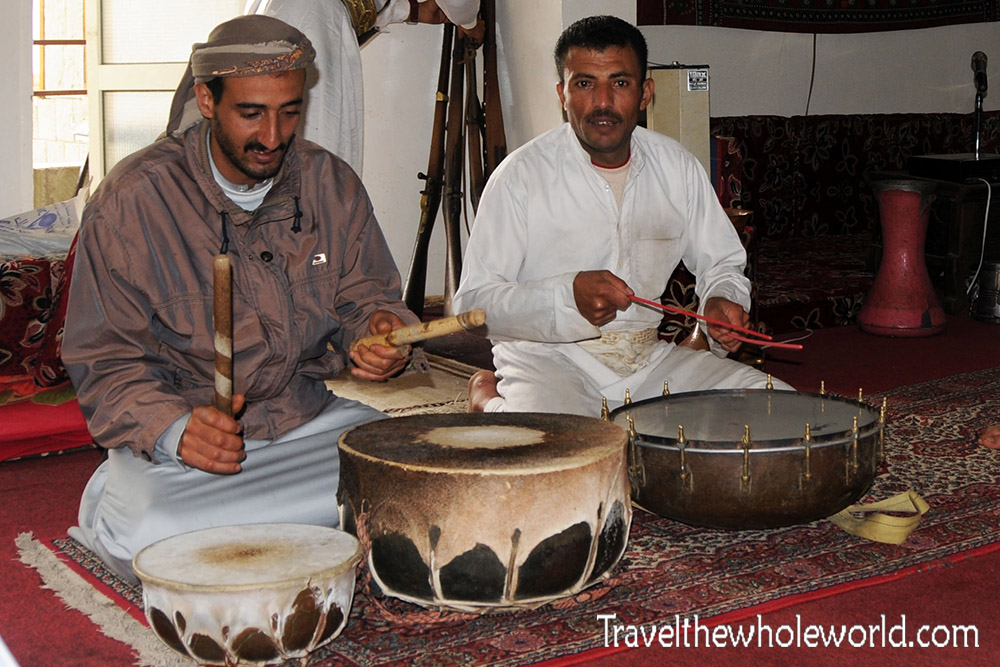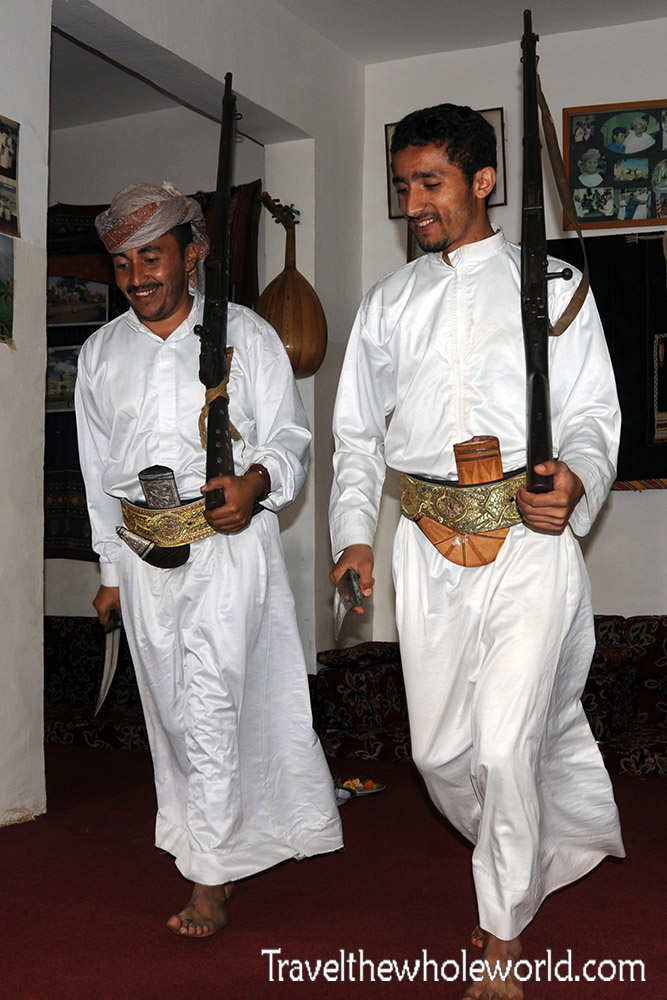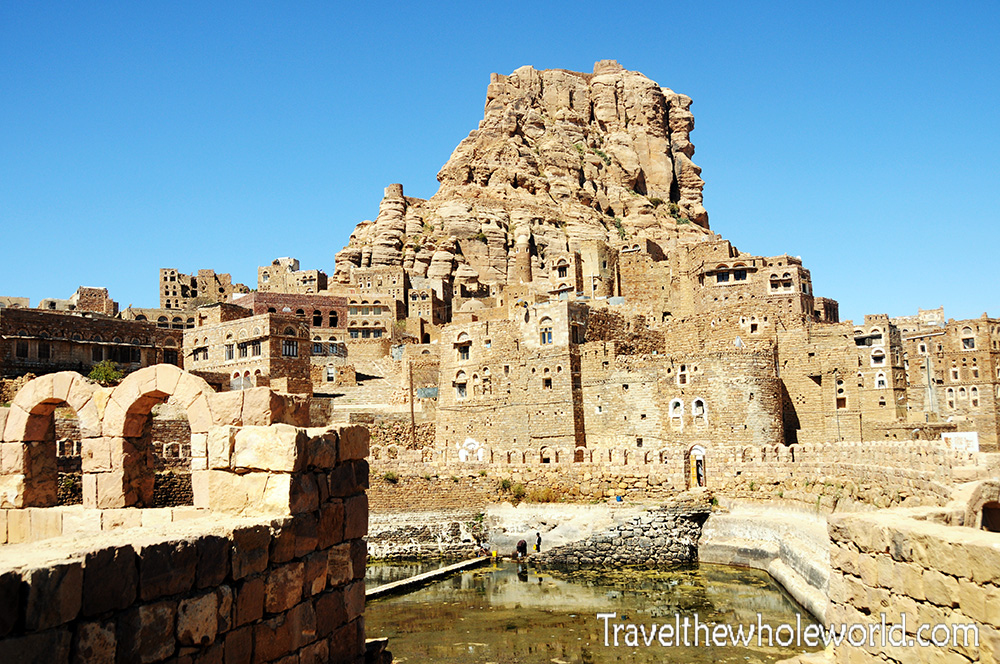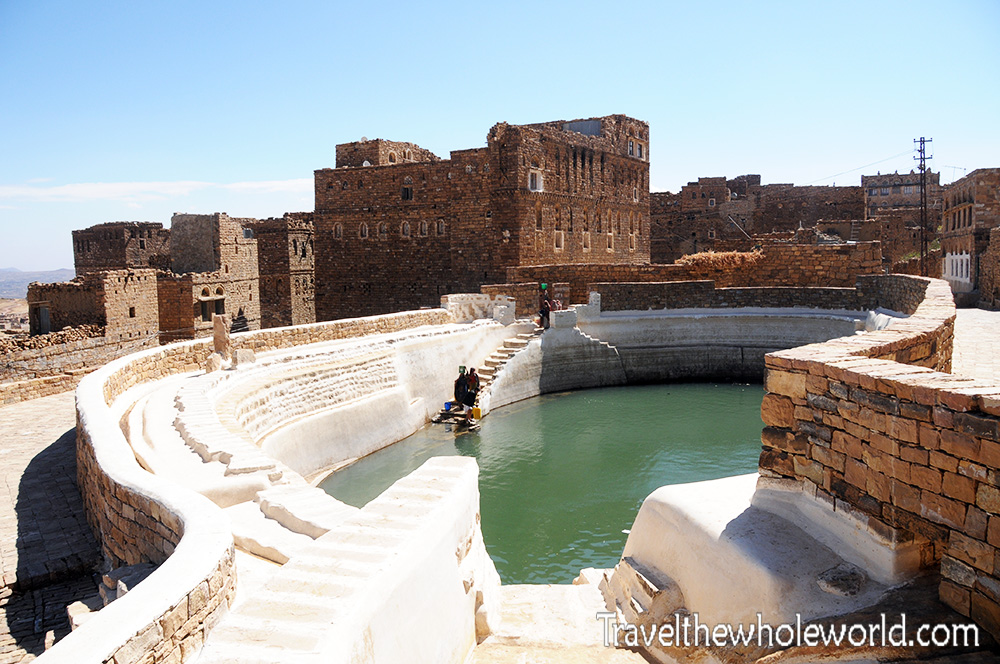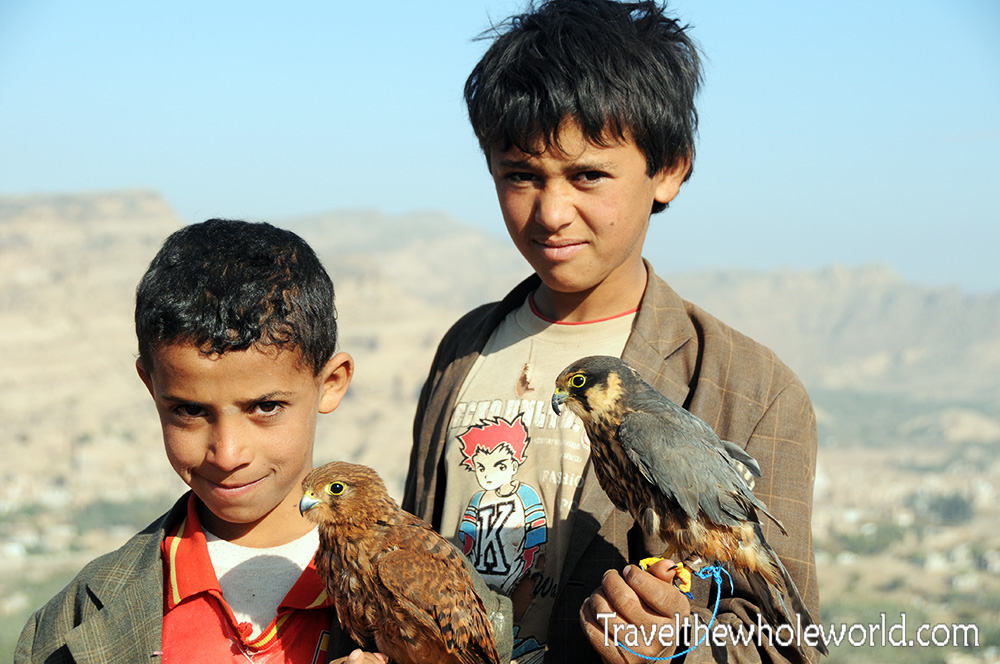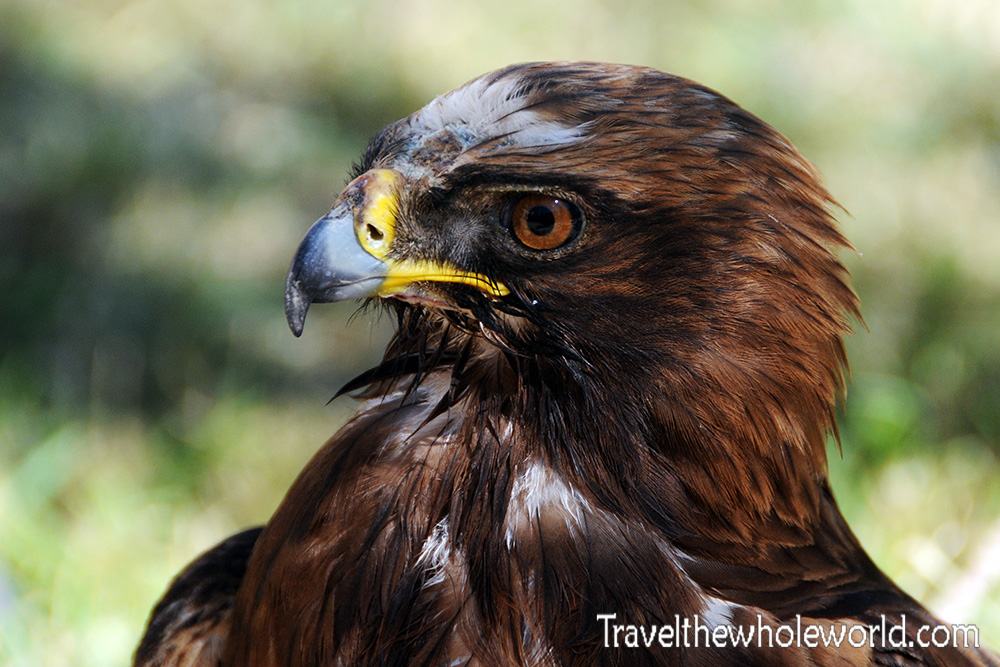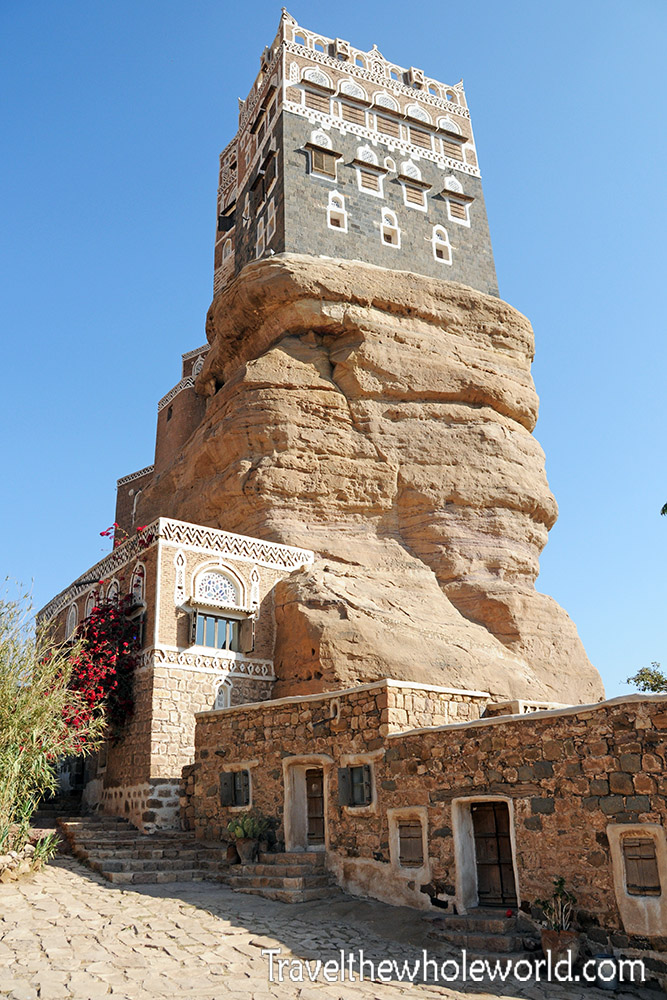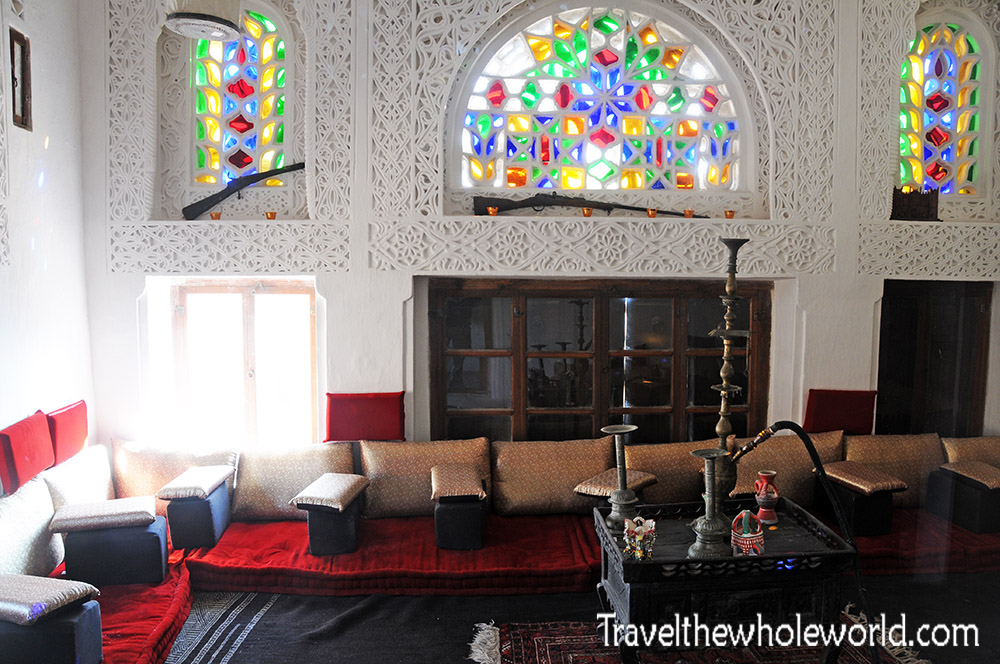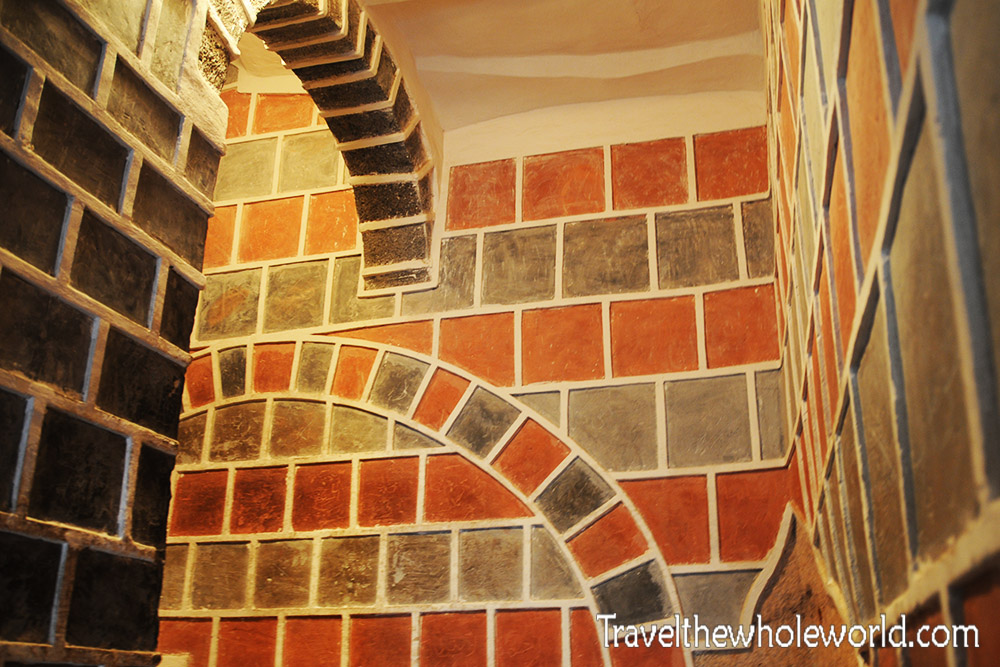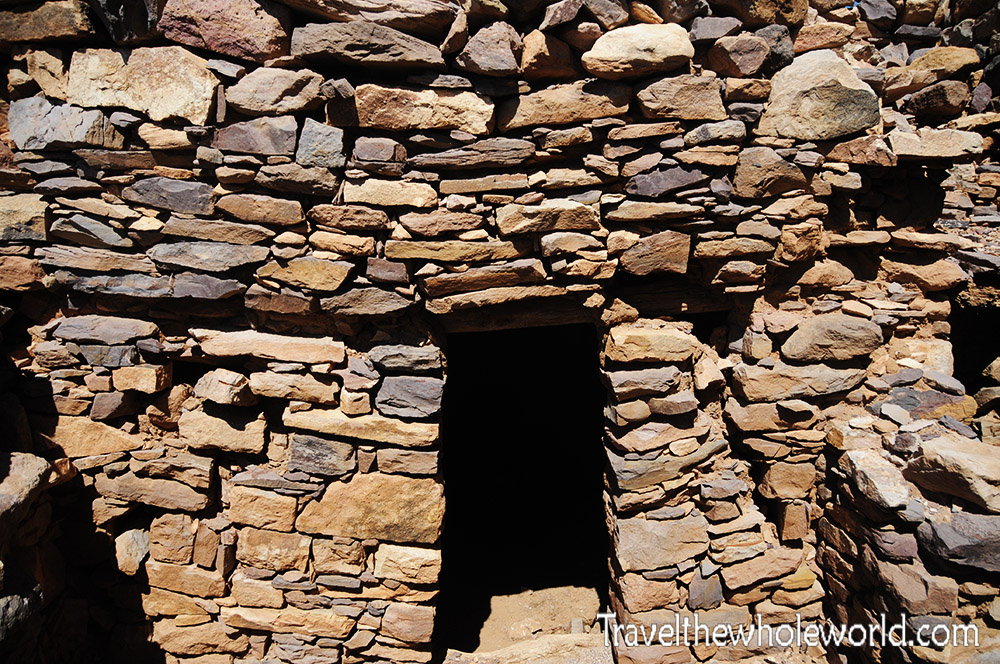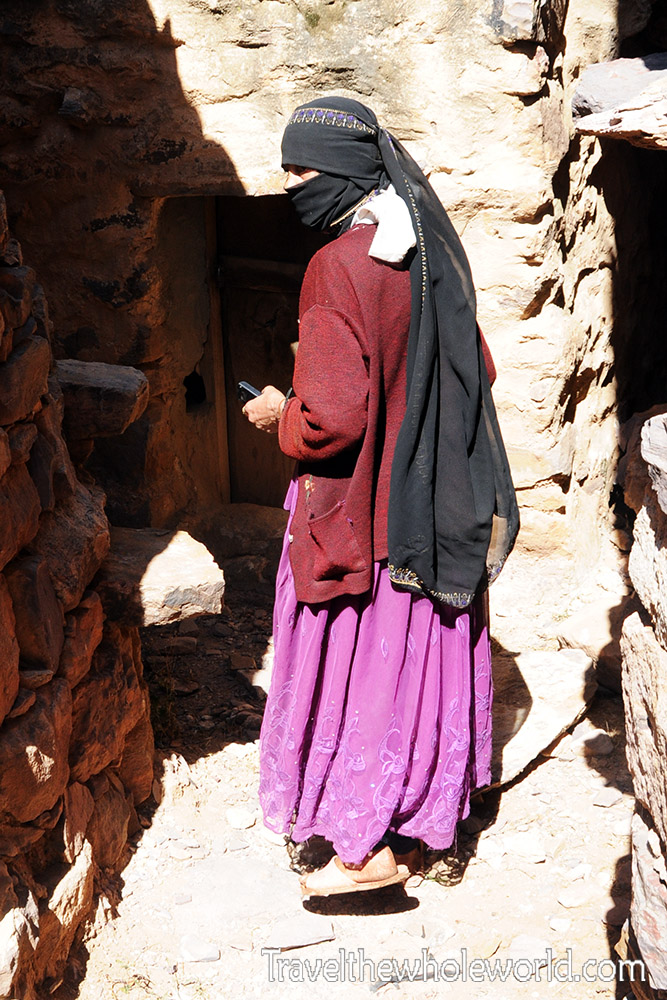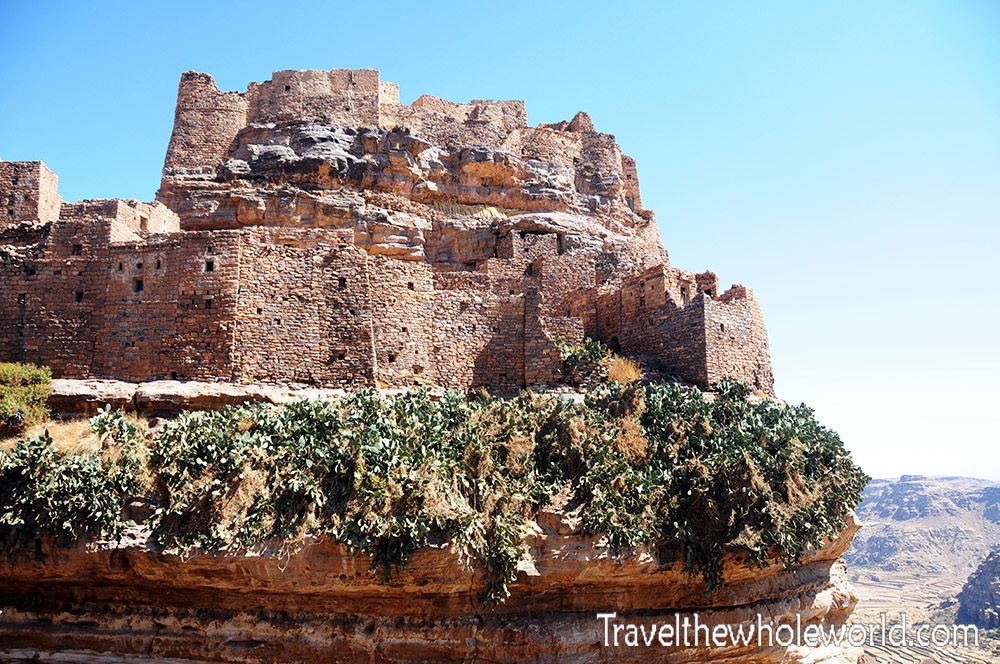Sana’a
The capital of Yemen is Sana’a located in the western side of the country high up in the mountains. At an altitude of 7,500 feet (2,300 meters), it’s one of the highest capital cities on earth. Sana’a’s history goes way back to the 6th century BC when the city was first founded also making it one of the oldest continuously inhabited cities in the world. Above is a photo of one of Sana’a’s districts.
I never really thought of Yemen as mountainous country before I visited. Even from the city though, the views of the mountains are amazing! Above is one of the highest peaks in the country. The highest mountain in Yemen is Jabal an Nabi Shu’ayb at an altitude of 12,028 feet (3,666 meters). It is also the highest mountain in the Arabian Peninsula.
When I visited Yemen, its president was Ali Abdullah Saleh. Saleh had led this country since the 1970’s going over 33 years. At the time of my visit, the president’s picture was seen in all over the capital like on cars, posted on walls, or framed pictures inside shops. I visited Yemen at an interesting time, the president of Tunisia had just been over thrown, and as the locals told me this is unheard of for an Arabic leader. Support for Saleh seemed to be mixed, but it seems the majority wanted him to move on after over three decades. Outside the capital, it was rare that I saw his picture. Only a month after my trip to Yemen, the ‘Arab Spring’ arrived which led to his fall.
Saleh’s power began with the North Yemen Civil War that took place in the 1960’s and ended in 1970. Royalists of the Mutawakkilite Kingdom fought the Yemen Arab Republic with superior number and equipment. The Yemen Arab Republic, often just called the republicans, received extensive support from other nations in the Middle East and even China. The republicans eventaully were victorious, but not after some serious fighting. The capital of Sana’a was even attacked at one point, and was under what’s known as the 70 day siege. This memorial above is actually dedicated to the siege of Sana’a and is located in Al Sabeen Square. Al Sabeen Square is the main square in Yemen where ceremonies and national events take place.
Something president Saleh did towards the end of his reign was built this enormous mosque below. Known as Saleh's Mosque, it was completed in 2008 and is a massive 294,000 square feet (27,300 meters)! Saleh's Mosque is also located within Al Sabeen Square.
Above is a photo of the main entrance to the King’s mosque, just recently completed in 2008. With a capacity of over 40,000 worshipers, this is the largest mosque in Sana’a and all of Yemen, and from what I saw once I entered, I assume it’s also the most beautiful.
These surrounding photos were all taken from inside the King’s mosque. This is seriously one of the most amazing religious buildings I’ve ever been in. The top photo was taken of the main interior where people gather to pray, below is a photo of one of the ceiling showing one of the domes rising up. I explored this place for a long time and even took some time to sit down and relax. I was enjoying myself until some guy approached me and asked if I was Muslim. I pretended like I didn’t understand and tried to dodge the question, but he was pretty persistent. Once I heard him asking others about my religion I left.
If I had just arrived to Yemen without any prior knowledge about the country, I’d guess this country’s economy was growing at a rate of 10% a year based on some parts of the city. In almost all areas of Sana’a I visited, new buildings seemed to be under construction, brand new roads were in place, and advertisements for future projects were found advertised along the roads. The photo above is of an advertisement of what the new airports in each city will look like. Below was one of many new buildings under construction. Before coming to the US, I had read that the Kuwaitis had funded dozens of construction projects in Yemen putting billions of dollars in investments. It’s sad to think but I’m sure many of these buildings were damaged during the fighting that later came and investments have ceased.
The rest of Sana’a is made up of countless districts, but the most impressive part by far is the old city. Old Sana’a is protected by a city wall that once had seven gates. The gates are over a 1,000 years old, and today only one is still standing. Above is a photo of the old city. This unique architecture you’ll find in Yemen is only found in this part of the world. Below is a photo of one of the city’s ancient minarets.
One of the main streets going through the Old City is River Road photographed above. You can see that both sides of the road are banked upwards with bricks and stones. When it rains hard in Sana’a, River Road becomes just that, and acts as a way to divert water out of the city. Below is a shot of the entrance to the suq, or the old city market. I took this picture while standing right in front of the old city’s gate.
Above and below are two photos from the old city’s suq. The most impressive suq I’ve ever been to was in Omdurman, Sudan. I can’t say that any market in Yemen came even close but they did sell similar items. Above are spices, nuts, and vegetables being sold. In the photo below are cooking utensils and likely some homemade pottery for sale. The market sells all kinds of items from meat, traditional daggers, silvers and gold to pretty much anything else you might need while in Yemen.
You’ll notice that from many of my photos of the Sana’a area most men carry the jambiya, or traditional dagger. In Arabic jambiya literally means dagger. When people use the word jambiya is used in the Middle East, it generally is referring to the Yemeni traditional dagger. I almost never buy souvenirs, but had to pick up two myself to take home with me! Above you can see some jambiyas being sold in the old suq market.
It was easy to get photographs of guys while traveling in Yemen, but for women it was much more difficult. Yemen is one of the most conservative countries I’ve ever visited. Every woman I saw wore a black burqa here in the capital and only a small percent of women had an open faced burqa. I didn’t see any exceptions in other parts of the country, but there were different colors further south with a mix with black and white in the east. A local told me that traditional Yemeni clothing has always been more colorful and the black burqas were introduced only two decades ago from the other gulf countries.
Something else about Yemen that has probably been a long tradition; it’s one of the highest countries in the world with armed civilians. On the upper right, a man passes by a market while carrying an AK-47. In all parts of the country this seemed to be consistent, in one market on the eastern side of Yemen, I counted four people with guns within about 5 minutes. One guy in Yemen told me a story about two friends who were arguing, and one guy took his pistol and slammed it on the other guys head accidentally discharging a round into someone standing nearby. Thinking he killed another one of his friends, he fled to the north of the country and went into hiding. When the family somehow got a hold of him and told him that he had shot is friend in the shoulder and everything was fine, he suspected they were lying and wanted him to come back to Sana’a so they could kill him in revenge. He eventually did go back and found out that his other friend he accidentally shot was fine, so to people in Yemen it turned out to be a funny story that had a happy ending.
There was only one art gallery that I stopped by during my entire visit to Yemen. I’m not sure of the name, but it had some paintings created by local Yemenis. I wish I took more photos of the artwork once inside to share but somehow this was the only photo I took. Sadly I was the only one here! Since this place is free there is no reason for anyone not to visit.
Really though, the entire city of Sana’a is a museum. This star of David on the was left behind when Jews lived in large numbers in Yemen. After the creation of Israel, almost all Jews who were living in Yemen moved there. Most Yemenis I came in contact told me that while they disliked Israel, not surprising, they didn’t have any hate for the Jewish religion. In fact many still consider Yemeni Jews living in Israel as their brothers, surprising!
Some other random experiences I had was when I passed by some outdoor cafe. These guys were roughly my age and attempted to start a conversation with me. They invited me to sit with them for some did, which of course I did. Unfortunately my Arabic was about as good as their English, so we weren’t able to have a real conversation. I would have loved to know their story and opinions on the world. I also wonder if they participated in the uprisings that began only weeks later.
After exploring much of Sana’a I did several day trips to areas nearby. This photo above is from outside of Sana’a in a small town called Manakhah. In order to leave Sana’a I was required to take an armed guard. Above is my driver on the left and my armed guard on the right. We had a traditional Yemeni lunch in Manakhah.
In Manakhah I had one of my favorite experiences in Yemen. We came to this small town to see the traditional drums and dancing that Manakhah is known for. These guys put on a good show and even forced me to join in at one point. This kind of music and dancing almost always take place during weddings throughout Yemen. The guy playing the drum on the left was awesome and one of the most curious people I ever met while traveling. He had a million questions for me; how do people go scuba diving? What happens if you hit a rock while skiing? How are homes heated in USA in the winter? I seriously wish I could have taken him with me!
Another impressive town outside Sana’a is Thula, also called Thilla. The town is pretty small but its history and architecture make it worth a visit if you’re in Sana’a. Over a thousand years old, the city has seen a lot in its life time and even was the birth place of a president. The great thing about the town is that it’s so well preserved. Yemen did do some restoration such as rebuilding the fort and watch towers. I spent lots of time hiking up the steep hills and exploring the small town.
Also restored in Thula was this ancient cistern. You can imagine that in a dry desert environment this is the people’s lifeline. While hanging out by the cistern I was approached by some interesting locals. They were pretty young, spoke English well, and had some very strong opinions on the world and Yemen. The leader of the group told me that Yemen had four problems that needed to be resolved. The first and biggest was Al Qaeda, second was the southern movement, third being tribal feuds, and finally the forth, was Yemen’s negative image on the media.
These kids above are from another small nearby town. Located by the desert canyon called Wadi Dhar, both kids had their own falcons. Besides the traditional hunting using falcons, the kids told me they used to show them to tourists and pose for pictures. An older kid who was here had broken glasses and told me his name was Harry Potter. Harry told me that they used to get 50 tourists here a day years back, now you are the only one he said. I regret not taking Harry Potter’s picture, his glasses were shattered because he had just dropped them the day before he told me.
Before coming to Yemen, I saw several pictures of this unique building while researching my trip. I kind of assumed it was just a large and creatively built house, but it’s actually an enormous summer palace. Known as Dar Al Hajar palace, it rises over 160 feet (50 meters) above the surrounding land, and was home to the Imam Yahya in the early 20th century.
The inside of the place has dozens of rooms ranging from a large kitchen, to dining rooms, bedrooms for the king, princesses and for the servants. I took a lot of photos of this place, but since I try to limit my pictures per country to around 100 and I’m closer to 150 for Yemen, I had to remove some. Above is a photo of one of the gathering areas where they would have meetings or dinner. The photo below shows one of the decorated stairwells that takes you to another floor. Today the entire complex is a museum, so you are free to explore every level.
About an hour from Sana’a I visited my final fortress. I came here at the very end of my trip, and to be honest I came across so many old castles while in Yemen that I wasn’t too motivated about visiting this one. Once I arrived though, I was taken away from the fortress itself as well as the amazing views. What was unique about this fortress to me was there were actually people still living here. As I wandered around I figured I had the whole place to myself. It wasn’t until I noticed that there were people eyeing me from their homes that I realized I wasn’t alone. Above is a photo of one of the houses in the lower parts of the fortress. The upper parts were actually locked and I was afraid they were off limits. This old woman photographed below came out and without speaking took me up and unlocked the gate for me.
Above is a photo of the entire Zakati Fortress. Since I was alone here and wasn’t able to speak to the locals I don’t know much about Zakati Fortress. All I know is that it’s ancient and high up in the mountains and I’m glad I didn’t miss it.
